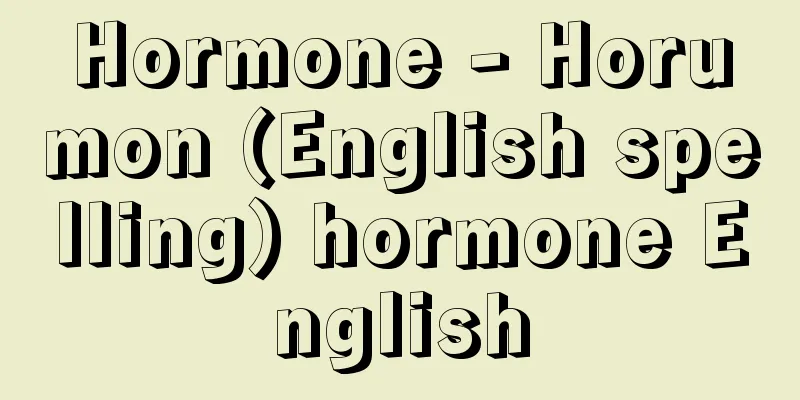Hormone - Horumon (English spelling) hormone English

|
A substance produced in a living body that exerts a specific effect on the morphogenesis, metabolism, growth, behavioral expression, and other physiological processes of the individual. This term was proposed by British physiologist E.H. Stirling in 1905. In his research with William Maddock Bayliss (1860-1924), he discovered secretin secreted from the duodenum (1902). He felt that the term "endocrine" used by C. Bernard was insufficient, and proposed the term "hormone" in his lecture. His definition, "a substance formed in a specific gland (endocrine gland) in an animal body, secreted into the blood, and transported from the gland to other organs (called target organs) far away in the body where it exerts a specific effect in minute amounts," was immediately accepted by the general public, but later came to include substances that are not transported through the blood and act on nearby cells or on one's own cells, and the meaning of the term has become broader. In addition, plant hormones and substances that are chemically synthesized and have a similar effect to those found in nature but have a different chemical structure are also called hormones. [Seiichiro Kawashima] Chemical Classification of HormonesHormones are classified into anterior pituitary hormones such as growth hormone and gonadotropic hormones, which have large molecular weights; protein-polypeptide hormones such as insulin and hypothalamic hormones; small-molecule amino acid derivative hormones such as adrenaline and thyroxine; small-molecule steroid hormones such as adrenal cortex hormones and sex hormones; and fatty acid derivative hormones such as prostaglandins. Of these, the molecular structures of almost all amino acid derivatives, steroid hormones, and fatty acid derivative hormones are determined, and many can be synthesized. The amino acid sequences of most protein-polypeptide hormones are determined, and some can be synthesized. In the history of hormone research (endocrinology), research on the mechanism of hormone action has been conducted in parallel with research on hormone purification, molecular structure determination, synthesis, and hormone receptors and genes. Purifying hormones is important because the effects of hormones are different when they are contaminated with even a small amount of another hormone, and a good example of this can be seen in the purification of insulin and glucagon (secreted by cells of the islets of Langerhans in the pancreas), which regulate blood sugar levels. In other words, when crude insulin, which is supposed to lower blood sugar levels, was injected, blood sugar levels temporarily rose. Investigating this phenomenon, it was discovered that crude insulin contained another hormone, glucagon, which led to the discovery of the hormone. [Seiichiro Kawashima] Hormonal actionAll animals, both vertebrates and invertebrates, have mechanisms to keep the internal conditions constant, that is, to maintain homeostasis (also known as homeostasis). The endocrine system, autonomic nervous system, and immune system play important roles in maintaining homeostasis. The autonomic nervous system and much of the endocrine system are centered in the hypothalamus, the diencephalon, where their activity is regulated. For example, in humans, blood sugar is maintained at about 100 milligrams per 100 milliliters, and body temperature fluctuates within 1 degree Celsius over the course of a day. The salt concentration in the blood is kept constant as a result of the endocrine system and autonomic nervous system, with hormones playing a particularly large role. Hormones also determine the manner of growth and the direction of differentiation. For example, thyroid hormones are the main factor in the transformation of tadpoles into frogs that can live on land. Hormones also determine whether the gonads of bony fish become ovaries or testes, whether the reproductive ducts become vas deferens or oviducts and a uterus, and regulate the growth of chicken combs. Hormones also directly or indirectly affect animal behavior, such as when migratory birds molt with new, stronger feathers before beginning their migration, when male cats chase females, and when salmon swim upstream in the rivers where they were born to spawn. [Seiichiro Kawashima] Vertebrate HormonesThe endocrine glands (endocrine organs) common to all vertebrates are the pineal gland, hypothalamus, pituitary gland, thyroid gland, islets of Langerhans, adrenal glands, and gonads. All vertebrates have anterior and posterior pituitary gland, but birds and some mammals lack the intermediate lobe. All amphibians and above have parathyroid glands. Fish, amphibians, reptiles, and birds have ultimobranchial glands, but cyclostomes (some jawless animals) do not. Mammals lack ultimobranchial glands, but the thyroid gland contains C cells that secrete calcitonin. Only mammals have a uterus, which has endocrine function. We will discuss the main hormones secreted by these glands. [Seiichiro Kawashima] Hypothalamic HormonesThe hypothalamus produces hormones that reach the anterior and intermediate lobes of the pituitary gland, where they stimulate or inhibit the secretion of individual hormones. One or several hypothalamic hormones are involved in each type of pituitary cell. These hormones include thyrotropin-releasing hormone (TRH, 3 amino acid residues), gonadotropin-releasing hormone (GnRH, also called luteinizing hormone-releasing hormone, LRH, 10 amino acid residues, which also acts as a follicle-tropin-releasing hormone), corticotropin-releasing hormone (CRH, 41 amino acid residues), growth hormone-releasing factor (GHRH, 40 and 44 amino acid residues in humans), release-inhibiting hormone somatostatin (14 and 28 amino acid residues), prolactin-releasing hormone (PrRH, 20 and 31 amino acid residues) and inhibitory factor (dopamine), and melanophore-stimulating hormone-releasing factor (MRF) and inhibitory factor (MIF) secreted from the intermediate lobe. The term "-- factor" will be changed to "-- hormone" once the chemical properties of the substance are elucidated and its physiological function is confirmed. In addition to the above, the posterior lobe hormones stored in the posterior pituitary gland and released from there are actually produced by special neurosecretory cells in the hypothalamus of the diencephalon. The neurosecretory substances produced by neurosecretory cells are large protein molecules, and the posterior lobe hormones are synthesized en masse as part of these molecules. The neurosecretory substances are transported through the axons to the posterior lobe and released into the blood as needed. There are ten known types of posterior lobe hormones produced by the decomposition of large protein molecules throughout vertebrates, all of which have nine amino acid residues (two cysteines are converted to cystine by disulfide bonds, so if cystine is counted, the number of residues is eight). Posterior lobe hormones are a good model of molecular evolution, and their ancestor is thought to be arginine vasotocin. It is believed that starting from arginine vasotocin, arginine vasopressin, lysine vasotocin, isotocin, mesotocin, oxytocin, glumitocin, varitosine, aspartatexin, etc. have arisen through an accumulation of mutations. The target organs of the posterior lobe hormones are the kidneys, bladder, uterus, mammary glands, etc. [Seiichiro Kawashima] Hormones of the anterior and intermediate pituitary glandThe posterior pituitary gland is part of the nervous tissue, while the anterior and intermediate lobes are called the adenohypophysis, which are formed when the Rathke's pouch (a pouch-like incision that appears during fetal development, when the mucosal epithelium of the pharynx extends toward the underside of the diencephalon) is in contact with the base of the brain. Among the hormones secreted from the anterior adenohypophysis, growth hormone (GH or STH) and prolactin (PRL) are simple proteins with approximately 200 amino acid residues. Thyroid-stimulating hormone (TSH), follicle-stimulating hormone (FSH), and luteinizing hormone (LH) are all glycoproteins that contain carbohydrates in their molecules, and are composed of two subunits with similar amino acid sequences. FSH and LH are collectively called gonadotropins (GTHs, also known as gonadotropins). Other hormones secreted by the anterior lobe include adrenocorticotropic hormone (ACTH, 39 amino acid residues) and adipokinetic hormone (there are two types; beta lipotropin, abbreviated as β-LPH, has 90 amino acid residues; gamma lipotropin, abbreviated as γ-LPH, has 58).Hormones secreted by the intermediate lobe include melanophore-stimulating hormone (there are two types; alpha MSH, abbreviated as α-MSH, has 13 amino acid residues; beta MSH has 18).ACTH, LPH and MSH are all produced by the breakdown of a precursor hormone called proopiomelanocortin.All hormones from the anterior and intermediate lobe act on lower target organs. [Seiichiro Kawashima] Thyroid hormonesThe thyroid gland stores thyroglobulin, a glycoprotein that contains iodine, and thyroid-stimulating hormone promotes its decomposition. The main thyroid hormones in the decomposition products are thyroxine and triiodothyronine. These have metabolic and metamorphic promoting effects on vertebrates in general, including humans. For example, they promote metamorphosis in amphibians, as well as the molting of reptiles and feathers in birds. [Seiichiro Kawashima] Parathyroid hormoneIn mammals, the parathyroid glands are attached as small nodules on the thyroid gland or are located nearby. The hormone is parathyroid hormone (PTH, also known as parathormone, with 84 amino acid residues), which increases blood calcium. In animals where the parathyroid glands have been removed, the calcium concentration in the blood decreases, causing increased nerve excitability, and the animal often suffers a tetany attack and suffocates to death. PTH secretion is regulated by the direct action of blood calcium concentration on the parathyroid gland, and is not directly controlled by the pituitary gland. Fish lack parathyroid glands, and calcium metabolism is regulated by the ultimobranchial gland and corpuscles of Stannius. [Seiichiro Kawashima] Ultimobranchial gland hormoneIn fish and birds, the ultimobranchial gland exists as an independent organ, but in mammals, the cells of the ultimobranchial gland are scattered throughout the thyroid gland as C cells. This hormone, calcitonin (32 amino acid residues), acts antagonistically to parathyroid hormone and reduces calcium levels in the blood. [Seiichiro Kawashima] Pancreatic hormonesThe pancreas consists of an exocrine gland that secretes pancreatic juice and endocrine glands called islets of Langerhans (islets) scattered throughout it. B cells (also called β cells), which make up the majority of the islets, secrete insulin. Insulin is a protein with a molecular weight of about 6000, and is initially produced as the large molecule proinsulin. Human proinsulin is a single-chain peptide with 84 amino acid residues, but when the intermediate connecting peptide (C chain) is removed, insulin is left, which consists of A chain and B chain linked by two S-S bonds. Blood glucose is taken up by the liver and muscles and stored as glycogen. It also promotes its use in tissues, lowering blood glucose levels. Glucagon, secreted from A cells (also called α cells), which are mainly distributed around the periphery of the islets, has a molecular weight of 3482, consists of 29 amino acid residues, and acts antagonistically to insulin. [Seiichiro Kawashima] Gastrointestinal HormonesMore than 20 types of active peptides are known to be secreted by endocrine cells scattered in the mucous membranes of the stomach, duodenum, and small intestine. Among them, gastrin (17 amino acid residues) promotes gastric juice secretion. Secretin is secreted from the mucous membrane when food acidified by gastric juice reaches the duodenum, and is transported to the pancreas, where it promotes the secretion of pancreatic juice. Secretin consists of 27 amino acids. Cholecystokinin (39 amino acid residues) is secreted from the mucous membranes of the stomach pylorus and the beginning of the small intestine, and promotes bile release and pancreatic juice secretion. In addition to the CCK-33, which has 33 residues at the C-terminus of cholecystokinin, CCK-8 and CCK-4 have also been found. Other active peptides with hormonal effects include galanin, motilin, bombesin, neurotensin, somatostatin, glenin, and neuropeptide Y. [Seiichiro Kawashima] Adrenal cortex hormonesThe adrenal gland consists of two parts that develop differently. One is the adrenal cortex, which is of mesodermal origin, and the other is the adrenal medulla, which is of ectodermal origin and is homologous to the sympathetic ganglion. In mammals, the cortex covers the central medulla, but in some animals, the two tissues are mixed (amphibians, birds, some reptiles), reversed (lizards), or each is scattered as several small nodules (fish). Adrenal cortical hormones are collectively called corticoids, and are divided into glucocorticoids and mineralocorticoids. When an animal is under stress, the secretion of glucocorticoids increases regardless of the type of stress. The name glucocorticoids comes from the fact that they act on proteins to carry out gluconeogenesis, which converts them into glucose (blood sugar). In humans, the main glucocorticoid is cortisol, but in rats and rabbits, corticosterone is mainly secreted. Birds, reptiles, and amphibians mainly secrete corticosterone, while fish mainly secrete cortisol. Mineralocorticoids play an important regulatory role in the metabolism of electrolytes in the blood. The secretion of glucocorticoids is promoted by adrenocorticotropic hormone, but the secretion of mineralocorticoids occurs without the involvement of the pituitary gland. The enzyme renin produced by the paraglomerular cells of the kidney acts on angiotensinogen in the blood to produce angiotensin I, which has 10 amino acid residues. Angiotensin I is converted by a converting enzyme in the blood to angiotensin II, which has 8 amino acid residues, and stimulates the adrenal cortex to promote the secretion of mineralocorticoids. The main mineralocorticoids from amphibians to mammals are aldosterone, and in most fish they are 11-deoxycortisol or 11-deoxycorticosterone. Corticoids are steroid hormones. [Seiichiro Kawashima] Adrenal Medullary HormonesAdrenaline and noradrenaline are secreted from the adrenal medulla. Adrenaline acts on the heart to increase blood pumping volume and raise blood pressure. It also raises blood sugar levels. Adrenal medulla hormones are secreted when you are under severe stress. [Seiichiro Kawashima] Gonadal HormonesThe primary function of the testes and ovaries is to produce reproductive cells, but they are also endocrine organs and secrete steroid hormones. The steroid hormones of the reproductive glands are divided into male hormones and female hormones (consisting of estrus hormones and luteinizing hormones). Male hormones (male sex hormones) are the main hormones secreted by the testes, and include testosterone and androsterone. When testosterone acts, it is converted to 5α-dihydrotestosterone in the tissues. It develops the male reproductive organs and causes the secondary male sexual characteristics (such as the comb in chickens and baleen in humans) to appear. Among the female sex hormones, estrus hormones are mainly secreted from the follicles of the ovaries, and develop the fallopian tubes, uterus, and vagina, maintaining their functions, as well as causing the expression of female sexual characteristics. Estradiol, estrone, and estriol are known as estrus hormones, with estradiol having the strongest effect. Luteal hormones are mainly secreted from the corpus luteum of the ovary, and act on the uterus to prepare for the implantation of the egg and maintain pregnancy. Most luteal hormones are progesterone. The ovaries secrete not only female hormones but also male hormones. It is exceptional for the testes to secrete opposite-sex hormones, but in humans, the testes secrete estrus hormones. The adrenal cortex secretes small amounts of male hormones in both sexes. [Seiichiro Kawashima] Placental hormonesThe placenta secretes various hormones. In the early stages of placental formation, gonadotropic hormone (CGH, which consists of two subunits like FSH and LH) is secreted from the chorion, stimulating the corpus luteum in the ovary and developing the placenta. As the placenta develops, placental prolactin, estradiol, progesterone, and other hormones are secreted. At this stage, in many mammals, the main role in maintaining pregnancy shifts from the ovary to the placenta. At the end of pregnancy, the placenta's secretion of progesterone decreases, and conversely, the secretion of prostaglandin F2α, which has a uterine contraction effect, increases, eventually leading to parturition. Prior to parturition, relaxin is secreted from the ovaries, loosening the pubic symphysis and facilitating the opening of the birth canal during parturition. [Seiichiro Kawashima] Other HormonesThe pineal gland is found in all vertebrates, but in fish, amphibians, and reptiles there is little evidence that it functions as an endocrine organ, being more of a photoreceptor. In mammals and birds, it may be called the pineal gland because it secretes the hormone melatonin (which inhibits the release of gonadotropic hormone and melanophore-stimulating hormone). The caudal pituitary gland, found only in fish, is a collection of axon terminals of neurosecretory cells scattered behind the spinal cord, and its structure resembles the posterior pituitary gland. It contains urotensin I, which has 41 amino acid residues, and urotensin II, which has 11 amino acid residues. Both have the effect of increasing blood pressure in fish. Corpuscles of Stannius are also endocrine glands found only in fish, and secrete hormones that reduce calcium in the blood. [Seiichiro Kawashima] Invertebrate HormonesNeurosecretory phenomena have been observed in animals ranging from coelenterates to higher arthropods, mollusks, and echinoderms. Most invertebrate hormones are neurosecretory substances, but some invertebrates have specially differentiated glandular endocrine organs that secrete hormones into body fluids. Invertebrate hormones have been well studied in crustaceans and insects. [Seiichiro Kawashima] Shellfish HormonesCrustaceans grow by periodically shedding their exoskeleton. This molting is regulated by the antagonistic molting-promoting and molting-inhibiting hormones. The molting-promoting hormone is secreted from the Y organ, a glandular endocrine organ. The location of the Y organ varies depending on the species of crustacean, and in crabs it is distributed on the lateral side of the prothorax. The molting-inhibiting hormone is produced in the X organ, located in the medulla terminalis of the ganglion in the eye stalk, and is transported to the sinus gland for release. There are known examples of crustaceans that undergo dramatic changes in body color, which are regulated by the chromatophore-stimulating hormone in the sinus gland. The sinus gland also secretes ovarian growth inhibitor hormone, which inhibits the development of the ovaries of crustaceans. For this reason, removing the eyestalks of shrimp, crayfish, and Japanese freshwater crabs allows the ovaries to mature outside of the breeding season. In most crustaceans, male sex hormones are secreted from androgenic glands (also called masculinizing glands) located at the ends of the vas deferens or at the tips of the testes. The androgenic glands are necessary for the differentiation of the testes and the development of male reproductive organs and secondary sexual characteristics; removal of the androgenic glands results in the males resembling females. [Seiichiro Kawashima] Insect HormonesThe growth of insects after hatching is regulated by hormones. In silkworms, the larval molt occurs when hormones from the corpus allata and the prothoracic gland act in conjunction, while the larvae molt and pupate when only the prothoracic gland hormone acts. Therefore, if the corpus allata is removed during the time of larval molt, only the prothoracic gland hormone acts and pupation occurs. The hormone of the corpus allata is called juvenile hormone because it maintains the larval characteristics. Three types of juvenile hormone with slightly different molecular structures have been identified. The prothoracic gland hormone is a type of steroid hormone called ecdysone. Ecdysone is synthesized in the neurosecretory cells of the brain, and after passing through the corpus cardiaca if present, its secretion is stimulated by the prothoracicotropic hormone (PTTH) released from the corpus allata. Two types of polypeptide hormones with molecular weights of approximately 4,400 and approximately 20,000 are known as prothoracicotropic hormones. The extent to which the development of the ovaries and reproductive appendages depends on the corpus allata varies with the species of insect. In cockroaches, earwigs, and blowflies, removal of the intercerebral neurosecretory cells leads to degeneration of the corpus allata and failure of ovarian maturation. Conversely, removal of the corpus allata in silkworms not only leads to precocious pupation but also to ovarian maturation. In some insect species, prothoracic hormones actively promote ovarian maturation. Prothoracic hormones generally stimulate the expression of adult traits, and without them neither molting nor metamorphosis occurs. [Seiichiro Kawashima] Other HormonesMany other hormones are known in invertebrates besides those mentioned above. For example, in cephalopod mollusks (octopus, squid), there is an endocrine gland called the ophthalmic gland (also called the optic gland because it is located on the optic stalk) between the brain and the optic lobe, which secretes gonadotropic hormones. Just like in mammals, there is no difference between the sexes in the hormone molecules themselves, and hormones produced by males cause the ovaries to mature, while hormones produced by females cause the testes to mature. The ophthalmic gland is under an inhibitory influence from the suboptic lobe. In a certain species of the annelid polychaete (polychaete worm), the neurosecretory cells in the brain are well developed. When this worm is cut, the front part of the body immediately regenerates. However, when the brain is removed, no regeneration is observed, confirming the presence of a regeneration-promoting hormone. [Seiichiro Kawashima] Hormone receptorsAlthough hormones reach all cells through the bloodstream, some cells respond to hormones and some do not. This is because the target cells that respond have receptors that bind to the hormone. Steroid hormones pass through the cell membrane and bind to receptors in the cytoplasm, and the hormone-receptor complex enters the nucleus and binds to specific sequences in gene DNA to regulate transcription. On the other hand, protein-peptide hormones are difficult to pass through cell membranes because of their large size and lack of lipid solubility. These hormone receptors are distributed on the cell membrane of target cells, and the hormones bind to them to transmit information into the cell. The transmitted information ultimately activates the transcriptional regulatory region to regulate transcription. Hormone molecules have mutated and become more diverse during the course of evolution, but their receptors have also mutated, increasing the diversity of their functions. [Seiichiro Kawashima] "Introduction to Comparative Endocrinology," "Hormonal Production and Secretion," "Biochemistry of Steroid Hormones," "Hormones and Reproduction I," "Hormones and Reproduction II," "Hormones and Reproduction III," "Hormones and Water/Electrolyte Metabolism," "Behavior and Hormones," "Sexual Differentiation and Hormones," and "Peptide Hormones" (1976-1991, Society Publishing Center) edited by the Japanese Biochemical Society. "New Biochemistry Experiment Course: Hormones 1, Peptide Hormones," "New Biochemistry Experiment Course: Hormones 2, Non-peptide Hormones" (1991, 1992, Tokyo Kagaku Dojin) edited by the Japanese Biochemical Society. "Growth Hormone and Related Peptides" edited by Kazuo Shizume (1992, Asakura Shoten). "Series: Brain Science: Hormones of the Brain - With Special Reference to the Frontal Lobe" by Shinji Ito (1993, Asakura Shoten). "Endocrinology at a Glance: Basic Knowledge of Hormones and Receptors" by Ben Greenstein, translated by Yoshiro Aso (1995, Medical Science International) ▽ "Animal Hormones" by Kawashima Seiichiro (1995, Shokabo) " ▽ "Aging and Hormones" by Kawashima Seiichiro (1995, University of Tokyo Press)" ▽ "Endocrinology" edited by Kawashima Seiichiro (1995, Asakura Shoten)" ▽ "Introduction to the Molecular Biology of Hormones, Growth Hormone and Prolactin Family, Reproduction and Hormones, Thyroid Hormones, Stress and Hormones, Development, Growth Factors and Hormones, Homeostasis, and Hormones of Invertebrates" edited by the Japanese Society for Comparative Endocrinology (1996-1998, Academic Press Center)" ▽ "Basic Chemistry Course: Life Science 3: Cells, Metabolism, and Hormones" by Hirose Shigehisa (1997, Maruzen)" ▽ "Illustrated Science of Hormones" by Oishi Masamichi (2000, Ohmsha)" ▽ "The 14th "University and Science" Public Symposium Organizing Committee, ed. "Steroid Hormones and Brain Science - Sex, Stress, and the Brain" (2000, Kubapro) " "The Brain and Hormones Controlling Sexuality" edited by Yamauchi Yoshihito and Arai Yasumitsu, supervised by Waseda University Human Research Center (2001, Corona Publishing)" "The Japanese Society for Comparative Endocrinology, ed. "Hormones Controlling Life - Trace Substances That Determine Animal Shape and Behavior" (2003, Kodansha Bluebacks)" [References] | | | | | | | | | | | | | | | | | | | | | | | | | | | | | | | | | | | | | | | | | | | | | | | gland| | gland| | | |progesterone| | |prolactin | | | | | | |Note: The diagram shows examples of anterior and posterior pituitary hormones in vertebrates . ©Shogakukan Schematic diagram of hormone secretion regulation ©Shogakukan "> Chemical structures of representative hormones (vertebrates) ©Shogakukan "> Chemical structure of representative hormones (ultimobranchial gland hormones) ©Shogakukan "> Chemical structure of representative hormones (invertebrates) Source: Shogakukan Encyclopedia Nipponica About Encyclopedia Nipponica Information | Legend |
|
生体内でつくられ、その個体の形態形成、代謝、成長、行動発現その他の生理的過程に特定の影響を及ぼす物質をいう。1905年にイギリスの生理学者E・H・スターリングによって提唱された用語である。彼はベイリスWilliam Maddock Bayliss(1860―1924)との研究で十二指腸から分泌されるセクレチンを発見(1902)し、「内分泌」というC・ベルナールの用語では不十分と感じて、「ホルモン」の語を彼の講演会で提案した。彼の定義、「動物体内の特定の腺(せん)(内分泌腺)で形成され、血液中に分泌され、その腺から遠く離れた体内の他の器官(標的器官とよぶ)に運ばれ、そこで、微量で特殊な影響を及ぼす物質」はただちに一般に受け入れられたが、その後、血液を介して運ばれず、すぐ隣の細胞や自らの細胞に作用するものも含まれるようになり、広い意味をもつようになった。 なお、植物ホルモンや、自然界に存在するものと化学構造は異なるが化学的に合成され類似の作用をもつものもホルモンとよぶ。 [川島誠一郎] ホルモンの化学的分類ホルモンは、分子量の大きな成長ホルモンや生殖腺刺激ホルモンなど下垂体前葉ホルモンや、インスリンや視床下部ホルモンなどのタンパク質‐ポリペプチド系ホルモン、小分子のアドレナリンやチロキシンなどのアミノ酸誘導体ホルモン、同じく小分子の副腎(ふくじん)皮質ホルモンや性ホルモンなどのステロイドホルモン、プロスタグランジンのような脂肪酸誘導体ホルモンなどに分けられる。このうち、アミノ酸誘導体系、ステロイドホルモンおよび脂肪酸誘導体ホルモンは、ほとんどすべて分子構造が決定されており、合成できるものが多い。タンパク質‐ポリペプチド系ホルモンの多くはアミノ酸配列が決定されており、合成できるものもある。ホルモンの研究(内分泌学)の歴史においては、ホルモンの作用機構の研究と併行して、ホルモンの精製、分子構造の決定、合成、ホルモンの受容体や遺伝子の研究が行われてきた。ホルモンを純化することは、微量でも別のホルモンが混入していると作用が異なるためにその意義が大きいのであるが、血糖量の調節にあずかるインスリンとグルカゴン(膵臓(すいぞう)のランゲルハンス島の細胞が分泌する)の純化にその好例をみることができる。すなわち、本来血糖値を下げる粗製インスリンを注射すると、逆に一時的に血糖値が上昇する現象がみられた。これを調べるうちに、粗製インスリン中に別種のホルモンが含まれていることがわかり、グルカゴンの発見につながった。 [川島誠一郎] ホルモンの作用脊椎(せきつい)動物でも無脊椎動物でも動物には体内の状態を一定に保つ仕組み、すなわちホメオスタシス(恒常性ともいう)を維持する仕組みが備わっている。ホメオスタシス維持機構には内分泌系、自律神経系、免疫系が重要な役割を果たしている。自律神経系と多くの内分泌系の中枢は、間脳視床下部にあり、活動が調節されている。たとえば、ヒトの血糖は100ミリリットル当り約100ミリグラムに保たれ、体温は1日の間に1℃以内の変動しかない。血液中の塩分濃度が一定に保たれているのは、内分泌系と自律神経系が働いた結果であり、とくにホルモンの果たす役割が大きい。 ホルモンは成長の仕方や分化の方向も決定する。たとえば、オタマジャクシが変態してカエルになり陸上生活ができるようになるのはおもに甲状腺ホルモンの作用である。硬骨魚類の生殖腺が卵巣になるか精巣になるかの決定、生殖輸管が輸精管になるか輸卵管と子宮になるかの決定、ニワトリのとさかの成長の調節などもホルモンの作用による。 渡り鳥が新しいじょうぶな羽に換羽してから渡りを開始したり、雄ネコが雌ネコを追い回したり、サケが産卵のために生まれた川をさかのぼるなどの動物の行動発現にも、ホルモンは直接的または間接的に作用している。 [川島誠一郎] 脊椎動物のホルモン全脊椎(せきつい)動物に共通した内分泌腺(内分泌器官)は、松果体・視床下部・下垂体・甲状腺・ランゲルハンス島・副腎・生殖腺である。下垂体前葉と後葉は全脊椎動物がもっているが、中葉は鳥類とある種の哺乳(ほにゅう)類にはない。副甲状腺(上皮小体)は両生類以上がもっている。鰓後腺(さいこうせん)は魚類・両生類・爬虫類・鳥類にあるが、円口類(無顎類の一部)にはない。哺乳類は鰓後腺を欠くが、甲状腺にカルシトニンを分泌するC細胞がある。子宮は哺乳類だけにあり、内分泌機能をもっている。これらが分泌するホルモンのうち主要なものについて述べる。 [川島誠一郎] 視床下部ホルモン視床下部は、下垂体前葉や中葉に達し、そこで個々のホルモンの分泌を促進したり抑制したりするホルモンを生産する。1種類の下垂体細胞に対して1ないし数種類の視床下部ホルモンが関与している。これらのホルモンには、甲状腺刺激ホルモン放出ホルモン(略号TRH。アミノ酸残基数3)、生殖腺刺激ホルモン放出ホルモン(GnRH。黄体形成ホルモン放出ホルモン、略号LRHともいう。アミノ酸残基数10。濾胞(ろほう)刺激ホルモン放出ホルモン作用をあわせもっている)、副腎皮質刺激ホルモン放出ホルモン(CRH。アミノ酸残基数41)、成長ホルモン放出因子(GHRH。アミノ酸残基数40と44:ヒト)と放出抑制ホルモンのソマトスタチン(アミノ酸残基数14と28)、プロラクチン放出ホルモン(PrRH。アミノ酸残基数20と31)と抑制因子(ドーパミン)、中葉から分泌される黒色素胞刺激ホルモンの放出因子(MRF)と抑制因子(MIF)などがある。「――因子」という用語は、その物質の化学的性質が解明され、それが生理的に働いていることが確認されれば、「――ホルモン」という名称に変更される。以上のほかに下垂体後葉に貯蔵され、そこから放出される後葉ホルモンも、実際には間脳視床下部にある特殊な神経分泌細胞で生産されている。神経分泌細胞のつくる神経分泌物質は大分子のタンパク質で、この分子の一部分として後葉ホルモンはまとめて生合成される。神経分泌物質は軸索の中を通って後葉に運ばれ、必要に応じて血液中に放出される。大分子のタンパク質が分解して生じた後葉ホルモンには、脊椎動物全般を通じて10種類が知られており、すべてアミノ酸残基数9である(2分子のシステインがS‐S結合によりシスチンとなっているためシスチンとして数えると残基数8となる)。後葉ホルモンは分子進化のよいモデルで、祖先分子はアルギニンバソトシンと考えられている。アルギニンバソトシンに出発し、アルギニンバソプレッシン、リジンバソプレッシン、リジンバソトシン、イソトシン、メソトシン、オキシトシン、グルミトシン、バリトシン、アスパルグトシンなどが突然変異の積み重ねで生じたと考えられている。後葉ホルモンの標的器官は腎臓、膀胱(ぼうこう)、子宮、乳腺などである。 [川島誠一郎] 下垂体前葉および中葉のホルモン下垂体後葉は神経組織の一部であるが、前葉と中葉はラトケ嚢(のう)(胎生期に現れる、咽頭(いんとう)の粘膜上皮が間脳下面に向かって伸びた袋状の切れ込み)が脳底に接して分化したもので、腺性下垂体とよばれる。腺性下垂体前葉から分泌されるホルモンのうち、成長ホルモン(GHまたはSTH)とプロラクチン(PRL)はアミノ酸残基数約200の単純タンパク質である。甲状腺刺激ホルモン(TSH)、濾胞刺激ホルモン(FSH)および黄体形成ホルモン(LH)は、いずれも分子中に炭水化物を含む糖タンパク質で、二つのサブユニットからなり、アミノ酸配列もよく似ている。FSHとLHをあわせて生殖腺刺激ホルモン(GTH。ゴナドトロピンともいう)とよぶ。このほかに前葉の分泌するホルモンに副腎皮質刺激ホルモン(ACTH。アミノ酸残基数39)と脂肪動員ホルモン(2種類ある。β(ベータ)リポトロピン、略号β‐LPHはアミノ酸残基数90。γ(ガンマ)リポトロピン、略号γ‐LPHは同58)がある。中葉の分泌するホルモンに黒色素胞刺激ホルモン(2種類ある。略号α(アルファ)‐MSHはアミノ酸残基数13。β‐MSHは同18)がある。ACTH、LPHおよびMSHはすべてプロオピオメラノコルチンという前駆体ホルモンの分解によって生ずる。前葉と中葉のホルモンはすべて下位の標的器官に作用する。 [川島誠一郎] 甲状腺ホルモン甲状腺はヨウ素を分子中に含むチログロブリンという糖タンパク質を蓄えているが、甲状腺刺激ホルモンはこの分解を促進する。分解産物中の甲状腺ホルモンのおもなものがチロキシンとトリヨードチロニンである。これらには、ヒトをはじめ脊椎動物一般に対して代謝や変態促進の作用があり、たとえば、両生類の変態促進作用のほか、爬虫(はちゅう)類の脱皮や鳥類の換羽を促進する。 [川島誠一郎] 副甲状腺ホルモン副甲状腺(上皮小体)は哺乳類では甲状腺上に小塊として付着するか、その付近にある。このホルモンは副甲状腺ホルモン(PTH。パラトルモンともいう。アミノ酸残基数84)で、血液中のカルシウムを増加させる。副甲状腺を摘出された動物では、血液中のカルシウム濃度が低下するために神経の興奮性が高まり、テタニーの発作をおこして窒息死を遂げることが多い。PTHの分泌調節は血液中のカルシウム濃度の副甲状腺に対する直接作用でなされ、下垂体の直接的支配は受けていない。魚類は副甲状腺を欠き、鰓後腺とスタニウス小体とによってカルシウム代謝を調節している。 [川島誠一郎] 鰓後腺ホルモン魚類から鳥類までは鰓後腺が独立した器官として存在するが、哺乳(ほにゅう)類では鰓後腺の細胞は甲状腺中のC細胞として散在する。このホルモンはカルシトニン(アミノ酸残基数32)で、副甲状腺ホルモンと拮抗(きっこう)的に作用し、血液中のカルシウム濃度を低下させる。 [川島誠一郎] 膵臓ホルモン膵臓は、膵液を分泌する外分泌腺と、その中に散在する内分泌腺のランゲルハンス島(膵島)からなっている。島の主体をなすB細胞(β細胞ともいう)はインスリンを分泌する。インスリンは分子量約6000のタンパク質であるが、初め大分子のプロインスリンとして生産される。ヒトのプロインスリンはアミノ酸残基数84の1本鎖のペプチドであるが、中間の結合ペプチド(C鎖)が除去され、2個のS‐S結合で結ばれたA鎖とB鎖からなるインスリンが残る。インスリンの作用で血糖は肝や筋肉に取り込まれ、グリコーゲンとして貯蔵される。また組織における利用も促し血糖値を下げる。島の周辺部に主として分布するA細胞(α細胞ともいう)から分泌されるグルカゴンは分子量3482で29個のアミノ酸残基からなり、インスリンと拮抗的に働く。 [川島誠一郎] 胃腸ホルモン胃、十二指腸、小腸の粘膜に散在する内分泌細胞で分泌される活性ペプチドは20種類以上知られている。そのうちのガストリン(アミノ酸残基数17)は胃液分泌を促進する。セクレチンは、胃液によって酸性になった食物が十二指腸に達するとその粘膜から分泌され、膵臓に運ばれ、膵液の分泌を促進する。セクレチンは27個のアミノ酸からなっている。コレシストキニン(アミノ酸残基数39)は胃幽門部と小腸起部の粘膜から分泌され、胆汁放出と膵液分泌を促進する。コレシストキニンのC末端33個のCCK‐33のほか、CCK‐8、CCK‐4もみいだされている。ホルモン作用のある活性ペプチドには以上のほかに、ガラニン、モチリン、ボンベシン、ニューロテンシン、ソマトスタチン、グレニン、ニューロペプチドYなどが知られている。 [川島誠一郎] 副腎皮質ホルモン副腎は発生の異なる二つの部分からなっている。一つは中胚葉(はいよう)起原の副腎皮質であり、他は外胚葉起原で交感神経節と相同の副腎髄質である。哺乳類では皮質が中央部の髄質を覆っているが、動物によっては両組織が混在したり(両生類、鳥類、一部の爬虫類)、逆転したり(トカゲ)、それぞれがいくつかの小塊として散在する(魚類)。副腎皮質ホルモンはコルチコイドと総称され、糖質コルチコイドと鉱質コルチコイドに分けられる。糖質コルチコイドは動物がストレス状態にあるとき、ストレスの種類に関係なく分泌が高まる。糖質コルチコイドの名称は、タンパク質に作用してブドウ糖(血糖)に変化させる糖新生を行うことによる。糖質コルチコイドとしてはヒトでは主としてコルチゾールであるが、ネズミとウサギでは主としてコルチコステロンが分泌される。鳥類、爬虫類、両生類はおもにコルチコステロン、魚類はおもにコルチゾールを分泌する。鉱質コルチコイドは血液中の電解質の代謝にとって重要な調節作用を営む。糖質コルチコイドの分泌は副腎皮質刺激ホルモンによって促進されるが、鉱質コルチコイドの分泌は下垂体と関係なしにもおこる。腎臓の傍(ぼう)糸球体細胞のつくる酵素レニンが血液中のアンギオテンシノーゲンに働いて、アンギオテンシンⅠというアミノ酸残基10個のものを切り出す。アンギオテンシンⅠが血液中の転換酵素によってアミノ酸残基8個のアンギオテンシンⅡになり、副腎皮質を刺激して鉱質コルチコイドの分泌を促す。両生類より哺乳類までのおもな鉱質コルチコイドはアルドステロン、ほとんどの魚類では11‐デオキシコルチゾールまたは11‐デオキシコルチコステロンである。なお、コルチコイドはステロイドホルモンである。 [川島誠一郎] 副腎髄質ホルモン副腎髄質からはアドレナリンとノルアドレナリンが分泌される。アドレナリンは心臓に作用して血液の拍出量を増加させ、血圧を高める。また、血糖値を高める。著しいストレス状態にあるときには副腎髄質ホルモンが分泌される。 [川島誠一郎] 生殖腺のホルモン精巣と卵巣は生殖細胞をつくることが本来の機能であるが、内分泌器官でもあり、ステロイドホルモンを分泌する。生殖腺のステロイドホルモンは雄性ホルモンと雌性ホルモン(発情ホルモンと黄体ホルモンからなる)に分けられる。 雄性ホルモン(男性ホルモン)は精巣の分泌するおもなホルモンであり、テストステロンとアンドロステロンがある。テストステロンは作用するときに組織で5α‐ジヒドロテストステロンに変わる。雄性器官を発達させ、雄の二次性徴(ニワトリのとさか、ヒトのひげなど)を発現させる。 雌性ホルモン(女性ホルモン)のうち発情ホルモンは、卵巣の濾胞から主として分泌され、輸卵管、子宮、腟(ちつ)を発達させ、それらの機能を維持するほか、雌性性徴を発現させる。発情ホルモンにはエストラジオール、エストロン、エストリオールが知られているが、エストラジオールがもっとも作用が強い。黄体ホルモンは卵巣の黄体から主として分泌され、子宮に作用し卵の着床を準備するとともに妊娠を維持する。黄体ホルモンのほとんどはプロゲステロンである。 卵巣は雌性ホルモンだけでなく雄性ホルモンも分泌する。精巣が異性ホルモンを分泌するのは例外的であるが、ヒトでは精巣が発情ホルモンを分泌している。副腎皮質は、雌雄ともに雄性ホルモンを微量ながらも分泌する。 [川島誠一郎] 胎盤のホルモン胎盤はさまざまなホルモンを分泌する。胎盤形成初期には絨毛(じゅうもう)膜から生殖腺刺激ホルモン(CGH。FSHやLHと同じく2個のサブユニットからなる)が分泌され、卵巣の黄体を刺激し、胎盤を発達させる。胎盤が発達すると、胎盤性プロラクチン、エストラジオール、プロゲステロンなどが分泌される。この時期になると妊娠維持の主役が卵巣から胎盤へ移行する哺乳類が多い。妊娠末期になると、胎盤のプロゲステロン分泌が低下し、逆に子宮収縮作用のあるプロスタグランジンF2αの分泌が増し、やがて分娩(ぶんべん)を迎える。分娩に先だち卵巣からリラキシンが分泌され、恥骨結合を緩め、分娩時の産道開大を容易にする。 [川島誠一郎] その他のホルモン松果体はすべての脊椎動物にあるが、魚類、両生類、爬虫類では内分泌器官として働いている証拠が弱く、むしろ光受容器である。哺乳類と鳥類ではホルモンとして作用するメラトニン(生殖腺刺激ホルモンと黒色素胞刺激ホルモンの放出を抑制する)を分泌するので松果腺とよんでよい。 魚類にのみある尾部下垂体は、脊髄後方に散在する神経分泌細胞の軸索末端が集合した部分で、その形式において下垂体後葉に似ている。アミノ酸残基41個のウロテンシンⅠとアミノ酸残基11個のウロテンシンⅡがある。ともに魚類で血圧を上昇させる作用がある。スタニウス小体も魚類にのみある内分泌腺で、血液中のカルシウムを減少させるホルモンを分泌する。 [川島誠一郎] 無脊椎動物のホルモン神経分泌現象は腔腸(こうちょう)動物から高等な節足動物、軟体動物、棘皮(きょくひ)動物に至るまで認められている。無脊椎動物のホルモンはほとんどが神経分泌物質であるが、ある種の無脊椎動物には特別に分化した腺性の内分泌器官があり、ホルモンを体液中へ分泌する。無脊椎動物のホルモンは甲殻類と昆虫類についてよく調べられている。 [川島誠一郎] 甲殻類のホルモン甲殻類は外骨格を周期的に脱ぎ捨てて成長する。この脱皮は拮抗的に働く脱皮促進ホルモンと脱皮抑制ホルモンによって調節されている。脱皮促進ホルモンは、腺性の内分泌器官であるY器官から分泌される。Y器官は甲殻類の種類により存在位置が異なり、カニでは前胸部側面に分布している。脱皮抑制ホルモンは、眼柄(がんぺい)内の神経節終髄にあるX器官で生産され、サイナス腺に運ばれて放出される。 甲殻類には目覚ましい体色変化をする例が知られており、サイナス腺の色素胞刺激ホルモンが調節している。また、サイナス腺は甲殻類の卵巣の発育を抑制する卵巣発育抑制ホルモンも分泌している。このため、スジエビ、ザリガニ、サワガニなどの眼柄を除去すると、繁殖期以外の時期に卵巣を成熟させることができる。 多くの甲殻類で、雄性ホルモンは輸精管の末端または精巣の先端に位置する造雄腺(雄性化腺ともいう)から分泌される。造雄腺は精巣の分化と雄性器官と二次性徴の発達に必要で、造雄腺を除去すると雌に似てくる。 [川島誠一郎] 昆虫のホルモン昆虫の孵化(ふか)後の成長はホルモンによって調節されている。カイコではアラタ体のホルモンと前胸腺のホルモンが共同して作用すると幼虫脱皮をおこし、前胸腺ホルモンだけが作用すると脱皮して蛹(さなぎ)になる。したがって、通常は幼虫脱皮をする時期にアラタ体を摘出すると、前胸腺ホルモンだけが作用して蛹化(ようか)する。アラタ体ホルモンは幼虫形質を維持させる働きがあるため、幼若ホルモンという。幼若ホルモンには分子構造がわずかに違う3種類が同定されている。前胸腺ホルモンはステロイドホルモンの一種で、エクジソンという。エクジソンは、脳の神経分泌細胞で合成され、側心体があればそこを通過したのち、アラタ体から放出される前胸腺刺激ホルモン(PTTH)によって分泌が促される。前胸腺刺激ホルモンには分子量約4400と約2万の2種のポリペプチド系ホルモンが知られている。 卵巣の発達と生殖腺付属器官の発達がどの程度アラタ体に依存しているかは、昆虫の種類によって異なる。ゴキブリ、ハサミムシ、クロバエなどは脳間部の神経分泌細胞を除去するとアラタ体が退化して卵巣が成熟しない。逆にカイコでは、アラタ体を除去すると、早熟的に蛹化するだけでなく卵巣も成熟する。昆虫の種類によっては、前胸腺ホルモンが卵巣の成熟を積極的に促進する。前胸腺ホルモンは一般に成虫形質の発現を刺激し、これがなければ脱皮も変態もおこらない。 [川島誠一郎] その他のホルモン以上のほかにも多くの無脊椎動物ホルモンが知られている。たとえば、軟体動物の頭足類(タコ、イカ)では、脳と視葉の間に眼腺(視柄上にあるため視柄腺ともいう)という内分泌腺があり、生殖腺刺激ホルモンを分泌する。このホルモン分子自体に雌雄差がないのは哺乳類と同じで、雄がつくるホルモンで卵巣が成熟するし、雌がつくるホルモンで精巣を成熟させることができる。眼腺は視柄下葉によって抑制的影響を受けている。 環形動物の多毛類(ゴカイ)のある種では脳の神経分泌細胞が発達している。このゴカイを切断しても、体の前方はただちに再生する。しかし脳を除去しておくと再生がみられないことから、再生促進ホルモンの存在が確かめられた。 [川島誠一郎] ホルモンの受容体ホルモンは血流にのってすべての細胞に到達するのに、ホルモンに反応する細胞と反応しない細胞とがある。これは、反応する標的細胞にはそのホルモンと結合する受容体があるからである。ステロイドホルモンは細胞膜を通過して細胞質内の受容体と結合し、ホルモン‐受容体複合体が核内に入り、遺伝子DNAの特定の配列に結合して転写を調節する。 一方、タンパク質‐ペプチド系ホルモンは、分子が大きいことと、脂溶性でないために、細胞膜を通過することがむずかしい。これらのホルモンの受容体は標的細胞の細胞膜上に分布していて、ホルモンはこれに結合して細胞内に情報が伝えられる。伝えられた情報は、最終的に転写調節領域を活性化して転写を調節する。 ホルモン分子は進化の過程で変異し、多様性を増大してきたが、それらの受容体も変異し、働きの多様性を増してきた。 [川島誠一郎] 『日本比較内分泌学会編『比較内分泌学序説』『ホルモンの生産と分泌』『ステロイドホルモンの生物化学』『ホルモンと生殖Ⅰ』『ホルモンと生殖Ⅱ』『ホルモンと生殖Ⅲ』『ホルモンと水・電解質代謝』『行動とホルモン』『性分化とホルモン』『ペプチドホルモン』(1976~1991・学会出版センター)』▽『日本生化学会編『新・生化学実験講座 ホルモン1 ペプチドホルモン』『新・生化学実験講座 ホルモン2 非ペプチドホルモン』(1991、1992・東京化学同人)』▽『鎮目和夫編著『成長ホルモンとその関連ペプチド』(1992・朝倉書店)』▽『伊藤真次著『シリーズ・脳の科学 脳のホルモン――前頭葉をめぐって』(1993・朝倉書店)』▽『ベン・グリースタイン著、麻生芳郎訳『一目でわかる内分泌学――ホルモンと受容体の基礎知識』(1995・メディカル・サイエンス・インターナショナル)』▽『川島誠一郎著『動物のホルモン』(1995・裳華房)』▽『川島誠一郎著『老化とホルモン』(1995・東京大学出版会)』▽『川島誠一郎編著『内分泌学』(1995・朝倉書店)』▽『日本比較内分泌学会編『ホルモンの分子生物学序説』『成長ホルモン・プロラクチンファミリー』『生殖とホルモン』『甲状腺ホルモン』『ストレスとホルモン』『発生と成長因子・ホルモン』『ホメオスタシス』『無脊椎動物のホルモン』(1996~1998・学会出版センター)』▽『広瀬茂久著『基礎化学コース 生命科学3 細胞・代謝・ホルモン』(1997・丸善)』▽『大石正道著『絵とき ホルモンの科学』(2000・オーム社)』▽『第14回「大学と科学」公開シンポジウム組織委員会編『ステロイドホルモンと脳科学――性・ストレス・脳をめぐって』(2000・クバプロ)』▽『早稲田大学人間総合センター監修、山内兄人・新井康允編著『性を司る脳とホルモン』(2001・コロナ社)』▽『日本比較内分泌学会編『生命をあやつるホルモン――動物の形や行動を決める微量物質』(2003・講談社ブルーバックス)』 [参照項目] | | | | | | | | | | | | | | | | | | | | | | | | | | | | | | | | | | | | | | | | | | | | | | | | | | | | | | | | | | | | | | | | |注:図は脊椎動物の下垂体前葉・後葉ホルモンの例©Shogakukan"> ホルモンの分泌調節模式図 ©Shogakukan"> 代表的なホルモンの化学構造(脊椎動物) ©Shogakukan"> 代表的なホルモンの化学構造(鰓後腺ホル… ©Shogakukan"> 代表的なホルモンの化学構造(無脊椎動物… 出典 小学館 日本大百科全書(ニッポニカ)日本大百科全書(ニッポニカ)について 情報 | 凡例 |
>>: Kholmsk (English spelling)
Recommend
Fourth rank official
The four ranks of government offices in the Taiho ...
Self-digestion - self-digestion
After death, the tissues of a living organism bre...
Hachiitsu
〘Noun〙 ("Hui" means a procession in Buga...
Stellar object - stellar object
Also known as quasars, quasars, and QSOs (short fo...
Direct measurement
…For example, the speed of an object is calculate...
Misato [village] - Misato
A village in Aki County in north-central Mie Prefe...
Hayashi Jussai
Born: June 23, 1768 (Meiwa 5) Mino [Died] July 14,...
Genoveva (Saint) (English spelling)
...saint. Her Latin name was Genoveva or Genovefa...
Mule deer
It is a mammal of the order Artiodactyla and the ...
Araliaceae
...The young shoots of many species of the Aralia...
Kinugasagai (English spelling) divested carrier shell
A gastropod of the family Caragana, class of the ...
Agnathids - Agnathids
A general term for fishes belonging to the phylum...
Shikama [town] - Shikama
A town in Kami County in north-central Miyagi Pref...
Rf
…However, soon after, criticism of this discovery...
aragonés (English spelling)
… [dialect] The Latin dialects in the north and c...

![Furudono [town] - Furudono](/upload/images/67ccbf887517c.webp)







